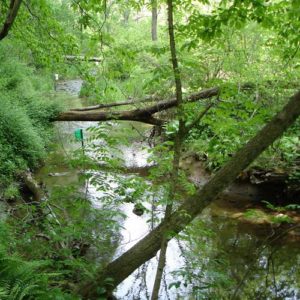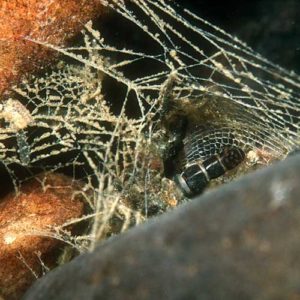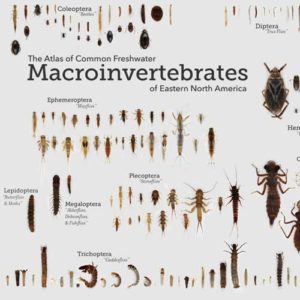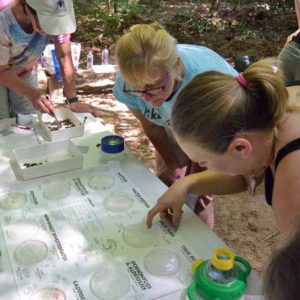In May, Stroud Water Research Center scientists attended the weeklong annual meeting of the Society for Freshwater Science (SFS) in Salt Lake City, Utah. The SFS annual meeting draws presentations from colleagues around the world. The theme of the 2019 annual meeting was “Translational Ecology in Freshwater Science.”
In the face of continuing environmental change and the magnitude of its complex and interacting effects on global freshwater, Translation Ecology (TE) provides a potential roadmap for freshwater science to inform real world decision-making. The foundational principles of TE include interdisciplinary collaboration, multidirectional engagement, long-term commitment, iterative communication, transparent and representative process, and a decision context that leads to actionable outcomes. (From https://sfsannualmeeting.org/)
Abbreviated abstracts of presentations by Stroud Water Research Center scientists and staff are shown below. Note: Stroud Center scientists and staff are indicated in bold.
Bacterial Succession in Headwater Biofilms

Primary Presenter/Author: Jinjun Kan
Co-Presenters/Authors: Jing Wang, Marc Peipoch, and Raven Bier
Microbial biofilms are vital components of nutrient uptake and cycling processes in freshwater ecosystems, but we are still learning how microbes colonize and develop to mature biofilms in stream waters. We evaluated succession of microbial communities initiated in both summer and winter in a well-studied catchment in southeastern Pennsylvania, USA. Results from this study have identified unique roles of phototrophic and heterotrophic bacteria in early and later stages of succession in freshwater streams, which is a key part for understanding ecological roles of microbes in freshwater as well as global aquatic ecosystems.
Biogeography of Bacteria in Headwaters Streams Across Biomes and Seasons
Primary Presenter/Author: Raven Bier
Co-Presenters/Authors: Jinjun Kan; Jennifer Mosher (Marshall University); and Louis Kaplan
Benthic microbial communities of headwater streams conduct important processes for maintaining critical stream ecosystem functions both within headwaters and downstream. Not all headwater communities are equal and there is a growing effort to understand which factors are responsible for differences among them and more generally to understand the utility and limitations of bacterial biogeography information. Using three well-studied catchments, White Clay Creek (PA, USA), Neversink River (NY, USA) and Rio Tempisquito (Costa Rica), we examined the influence of catchment, season, substrate type (rock vs. sediment), stream order, and water chemistry on the composition of streambed microbial communities characterized by 16S rRNA genes. Our results suggest that changes in benthic substrate could substantially alter the biogeography of bacteria in headwater streams, globally.
High-Resolution Spatio-Temporal DOM Dynamics in White Clay Creek, Pennsylvania
Primary Presenter/Author: Diana Oviedo-Vargas
In the last decades, several absorbance-based metrics have been developed to help quantify dissolved organic carbon concentrations, characterize the complex chemical character of dissolved organic matter (DOM), and identify DOM sources and processing in the environment. Using in situ spectrophotometers to measure high-frequency absorbance spectra, we evaluated how DOM dynamics reflected watershed and reach-scale biogeochemical processes in White Clay Creek, a temperate third-order stream in Pennsylvania, USA.
Widespread Cryptic Bacterial Infections in Benthic Biofilm Communities
Primary Presenter/Author: Kurt Williamson (College of William and Mary)
Co-Presenters/Authors: Alexandra Payne and Abigail Davidson (College of William and Mary); Jinjun Kan, Raven Bier, Jing Wang, and Marc Peipoch
As the most ubiquitous biological entities on earth, viruses have important impacts on aquatic microbial ecology and have been studied at length in the global ocean. However, the role of bacteriophage in lotic ecosystems, particularly in benthic biofilms, has gone largely unstudied. We hypothesized that temperate bacteriophage can circumvent the protective cuticle covering most biofilms through integration into bacterial genomes. Our results suggest that bacteriophage can infect freshwater biofilms through lysogenic infection, with important implications for stream ecology.
Thermal Restoration in a Fragmented Landscape
Primary Presenter/Author: Valerie Ouellet (University of Birmingham)
Co-Presenters/Authors: Melinda Daniels
Understanding how riparian forest fragmentation affects stream thermal regimes is essential to inform effective land management programs aiming to achieve thermal restoration and/or resilience in the face of projected climate warming. Here we present the results from a landscape-level study to evaluate the effects of riparian forest buffer quality on the thermal regimes of headwater streams. Our results suggest that effective conservation and restoration efforts should focus on protecting, improving and connecting riparian forest buffers by looking at thermal regimes and thermal habitat structure at different scales.
Riparian Forest Restoration Transforms Stream Channel Geomorphology: Timescales and Mechanisms of Biogeomorphic Change
Primary Presenter/Author: Melinda Daniels
Plants act as effective river ecosystem engineers across spatial scales from individual plants to entire watersheds, through time as biomass changes within the annual growth cycles, over longer term growth and senescence trajectories, and in response to external climatic, hydrological and geomorphological fluctuations and extreme events. Riparian and in-channel vegetation management is increasingly utilized as a tool in stream restoration and management, yet little is known regarding the timescales of river response to vegetation manipulation. The purpose of this paper is to review the utility of plants as river restoration engineers and present the results of a 40 year riparian reforestation experiment as a case study illustration of the dramatic in-channel geomorphological changes induces by conversion from grass to forest dominated riparian vegetation. Experimental results show widening and shallowing of channel geometry and overall coarsening of the substrate. Channel change accelerates upon delivery of in-channel wood from the maturing riparian forest, suggesting that the engineering potential of vegetation may not be maximized until structural maturity and complex age structures are achieved.
Facilitation by Ecosystem Engineers Differentially Influences Invertebrate Size Structure Across a Stress Gradient

Primary Presenter/Author: Benjamin Tumolo (Montana State University)
Co-Presenters/Authors: Lindsey Albertson (Montana State University) and Melinda Daniels
The community-level consequences of ecosystem engineering are relatively understudied. We explore how net-spinning caddisfly (Hydropsychidae) retreats differentially facilitate macroinvertebrate communities by identifying traits of the beneficiaries along an environmental gradient. Our findings indicate that individuals using retreats in higher stress sites represent a greater proportion of the community size structure compared to lower stress sites. These results highlight the complexities between ecosystem engineered facilitation, traits of the surrounding community, and abiotic environments.
Structural and Functional Trajectories of Biofilm Community Succession
Primary Presenter/Author: Marc Peipoch
Co-Presenters/Authors: Raven Bier, Jing Wang, and Jinjun Kan
Limited understanding of biofilm community succession precludes our ability to forecast short-term responses of stream ecosystems to pressing environmental problems such as increasing sediment loads or flooding frequency. To examine succession trajectories of biofilm structure and function we employed artificial streams in which epilithic biofilms were first developed to mature stages and then exposed to flooding disturbances of contrasting intensity. Over a six-week period, we monitored structural (bacteria and algal abundance and diversity) and functional (species interactions, nutrient uptake, and enzyme activity) attributes pre- and post-disturbance.
Montana Consortium for Research on Environmental Water Systems: Application to Water Quality Issues in the Upper Clark Fork River
Primary Presenter/Author: H. Maurice Valett (University of Montana)
Co-Presenters/Authors: Benjamin Colman (University of Montana); Wyatt Cross and Juliana D’Andrilli (Montana State University); Michael DeGrandpre (University of Montana); Jerry Downey (Montana Tech); Robert Hall (Flathead Lake Biological Station, University of Montana); Elizabeth Metcalf (University of Montana); Robert Payn (Montana State University, Montana Institute on Ecosystems); and Marc Peipoch
The Montana Consortium for Research on Environmental Water Systems represents a multi-institutional and interdisciplinary program applying molecular, engineering, ecological, and social sciences to water quality issues associated with mining, agricultural, and energy extraction across Montana. As one of the focal systems, the Upper Clark Fork River is being monitored for biogeochemical and biological recovery from over a century of mining influences and contemporary nutrient enrichment, while addressing how rural human communities respond to changes in water quality using a community resilience framework.
Heterotrophic Regimes in Rivers: Partitioning Sources of Ecosystem Respiration Through a Time-Series Analysis
Primary Presenter/Author: Enrico Bertuzzo (University Cà Foscari Venice)
Co-Presenters/Authors: Erin Hotchkiss, (Virginia Tech); Alba Argerich (University of Missouri); John Kominoski (Florida International University); Diana Oviedo-Vargas; Philip Savoy (Duke University); Rachel Scarlett (Purdue University); Daniel von Schiller (University of the Basque Country); and Jim Heffernan (Duke University)
Respiration in streams is controlled by the timing, magnitude, and quality of organic matter (OM) inputs from internal production and external fluxes. Here, we tested how well current understanding of respiration drivers predict seasonal metabolic patterns. Results generally agree with conceptual predictions, but the detailed analysis of this rich dataset allowed shedding further light on how catchment size and the position control the heterotrophic regimes of streams and rivers.
Macroinvertebrates.org: An Interdisciplinary Collaboration to Build a Digital Teaching Collection for Aquatic Macroinvertebrate Identification

Primary Presenter/Author: Tara Muenz
Co-Presenters/Authors: Jessica Roberts (Carnegie Mellon University); John C. Morse (Clemson University); John Wenzel and Andrea Kautz (Carnegie Museum of Natural History); Marti Louw (Carnegie Mellon University)
A persistent challenge in training volunteers to reliably and accurately identify aquatic macroinvertebrates lies in the creation of resources that convey entomological knowledge at the appropriate level for new learners with diverse backgrounds and experiences. Macroinvertebrates.org is an innovative digital teaching and learning tool that addresses these issues by presenting explorable, high-resolution annotated images with supplemental multimedia to support the development of identification skills. Through this interdisciplinary collaboration, we are building an interactive visual atlas of the most commonly found freshwater macroinvertebrates in the Eastern United States to help volunteers learn to see key diagnostic characters, with the ultimate aim of increasing the value of citizen-generated data for conservation and environmental decision-making.
Taxonomic Identification Workshop and Citizen Scientist Certification Pilot Test

Since 2015, the Society for Freshwater Science has provided funds to the Stroud Center to deliver a Leaf Pack Network® workshop in conjunction with the annual meeting. Always occurring prior to the conference, this workshop teaches local educators about the importance of aquatic macroinvertebrates as indicators of stream health, how to monitor and identify this taxonomic group, and how to bring these concepts into their classrooms. The workshops have been presented in Florida, Oregon, Wisconsin, California, Michigan, and most recently, Utah.
This year’s workshop had a new spin: to pilot a volunteer-level certification in aquatic macroinvertebrate identification through the society’s Taxonomic Certification Program (TCP), which is coordinated by Stroud Center entomologist Mike Broomall. Distinguished Research Scientist Emeritus Bernard Sweeney, Ph.D., obtained additional funding through the society to create this new level of certification, and Assistant Director of Education Tara Muenz assisted in the creation and delivery of the workshop and training, which was held on Saturday, May 18 at the Kaysville Education Center in Kaysville, Utah.
The new test, which will be completed and launched later in 2019, is image-based, consisting of 50–60 identification questions where the test taker will need to score at least 95% in order to obtain certification. To learn more about this new certification, please contact Mike Broomall at tcp@stroucenter.org.
Land Use Effects on a Temporal Comparison of the Presence and Abundance of Microplastics in Riverine Systems
Poster Co-Presenters/Authors: John Jackson; Marisa Macchia, Austin Harrison, Rachel McNeish, John Wallace (California State University, Bakersfield)
The environmental contamination of microplastics (MPs) in marine and freshwater ecosystems is of increasing concern due to their capacity to adsorb persistent organic pollutants, persist long-term in the environment, and cause gut irritation in aquatic organisms. Microplastics are plastic particles <5mm in diameter, originate from industrial production and degradation of large plastic debris. The purpose of this research is to share preliminary findings on a collaborative project where we are assessing the effect of land-use on the presence and concentration of MP within aquatic invertebrate gut tissues from headwater and abundance of MPs. Streams did not present statistical differences in MP concentration between land systems in the Schuylkill Watershed, Schuylkill County, Pennsylvania, USA. Macroinvertebrates collected from streams within forested, agricultural and urban land-use are processed for the presence use. Dipteran, Coleopteran, and Trichopteran taxa contained the highest concentration of MP across streams from all land-uses. We did not find a significant difference in MP concentration between feeding groups. Understanding the abundance and distribution of MP in aquatic systems will allow us to comprehend the role of land-use in microplastic contamination aquatic food webs.



